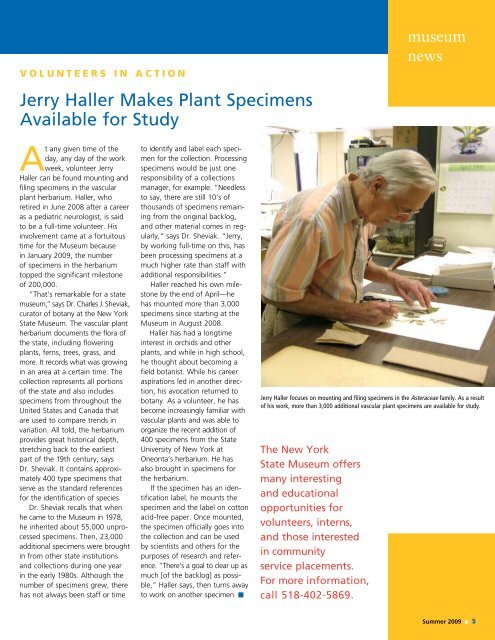Distinctly Dutch - New York State Museum
Distinctly Dutch - New York State Museum
Distinctly Dutch - New York State Museum
Create successful ePaper yourself
Turn your PDF publications into a flip-book with our unique Google optimized e-Paper software.
volunteers in action<br />
Jerry Haller Makes Plant Specimens<br />
Available for Study<br />
museum<br />
news<br />
At any given time of the<br />
day, any day of the work<br />
week, volunteer Jerry<br />
Haller can be found mounting and<br />
filing specimens in the vascular<br />
plant herbarium. Haller, who<br />
retired in June 2008 after a career<br />
as a pediatric neurologist, is said<br />
to be a full-time volunteer. His<br />
involvement came at a fortuitous<br />
time for the <strong>Museum</strong> because<br />
in January 2009, the number<br />
of specimens in the herbarium<br />
topped the significant milestone<br />
of 200,000.<br />
“That’s remarkable for a state<br />
museum,” says Dr. Charles J. Sheviak,<br />
curator of botany at the <strong>New</strong> <strong>York</strong><br />
<strong>State</strong> <strong>Museum</strong>. The vascular plant<br />
herbarium documents the flora of<br />
the state, including flowering<br />
plants, ferns, trees, grass, and<br />
more. It records what was growing<br />
in an area at a certain time. The<br />
collection represents all portions<br />
of the state and also includes<br />
specimens from throughout the<br />
United <strong>State</strong>s and Canada that<br />
are used to compare trends in<br />
variation. All told, the herbarium<br />
provides great historical depth,<br />
stretching back to the earliest<br />
part of the 19th century, says<br />
Dr. Sheviak. It contains approximately<br />
400 type specimens that<br />
serve as the standard references<br />
for the identification of species.<br />
Dr. Sheviak recalls that when<br />
he came to the <strong>Museum</strong> in 1978,<br />
he inherited about 55,000 unprocessed<br />
specimens. Then, 23,000<br />
additional specimens were brought<br />
in from other state institutions<br />
and collections during one year<br />
in the early 1980s. Although the<br />
number of specimens grew, there<br />
has not always been staff or time<br />
to identify and label each specimen<br />
for the collection. Processing<br />
specimens would be just one<br />
responsibility of a collections<br />
manager, for example. “Needless<br />
to say, there are still 10’s of<br />
thousands of specimens remaining<br />
from the original backlog,<br />
and other material comes in regularly,”<br />
says Dr. Sheviak. “Jerry,<br />
by working full-time on this, has<br />
been processing specimens at a<br />
much higher rate than staff with<br />
additional responsibilities.”<br />
Haller reached his own milestone<br />
by the end of April—he<br />
has mounted more than 3,000<br />
specimens since starting at the<br />
<strong>Museum</strong> in August 2008.<br />
Haller has had a longtime<br />
interest in orchids and other<br />
plants, and while in high school,<br />
he thought about becoming a<br />
field botanist. While his career<br />
aspirations led in another direction,<br />
his avocation returned to<br />
botany. As a volunteer, he has<br />
become increasingly familiar with<br />
vascular plants and was able to<br />
organize the recent addition of<br />
400 specimens from the <strong>State</strong><br />
University of <strong>New</strong> <strong>York</strong> at<br />
Oneonta’s herbarium. He has<br />
also brought in specimens for<br />
the herbarium.<br />
If the specimen has an identification<br />
label, he mounts the<br />
specimen and the label on cotton<br />
acid-free paper. Once mounted,<br />
the specimen officially goes into<br />
the collection and can be used<br />
by scientists and others for the<br />
purposes of research and reference.<br />
“There’s a goal to clear up as<br />
much [of the backlog] as possible,”<br />
Haller says, then turns away<br />
to work on another specimen. n<br />
Jerry Haller focuses on mounting and filing specimens in the Asteraceae family. As a result<br />
of his work, more than 3,000 additional vascular plant specimens are available for study.<br />
The <strong>New</strong> <strong>York</strong><br />
<strong>State</strong> <strong>Museum</strong> offers<br />
many interesting<br />
and educational<br />
opportunities for<br />
volunteers, interns,<br />
and those interested<br />
in community<br />
service placements.<br />
For more information,<br />
call 518-402-5869.<br />
Summer 2006 2009 n 5
















